NCERT Solutions | Class 12 Maths Chapter 5 | Continuity and Differentiability

CBSE Solutions | Maths Class 12
Check the below NCERT Solutions for Class 12 Maths Chapter 5 Continuity and Differentiability Pdf free download. NCERT Solutions Class 12 Maths were prepared based on the latest exam pattern. We have Provided Continuity and Differentiability Class 12 Maths NCERT Solutions to help students understand the concept very well.
NCERT | Class 12 Maths
| Book: | National Council of Educational Research and Training (NCERT) |
|---|---|
| Board: | Central Board of Secondary Education (CBSE) |
| Class: | 12th |
| Subject: | Maths |
| Chapter: | 5 |
| Chapters Name: | Continuity and Differentiability |
| Medium: | English |
Continuity and Differentiability | Class 12 Maths | NCERT Books Solutions
NCERT Solutions for Class 12 Maths Chapter 5 Continuity and Differentiability Exc 5.1
Ex 5.1 Class 12 Maths Question 1.
Prove that the function f (x) = 5x – 3 is continuous at x = 0, at x = – 3 and at x = 5.
Solution.
(i) At x = 0. limx–>0 f (x) = limx–>0 (5x – 3) = – 3 and
f(0) = – 3
∴f is continuous at x = 0
(ii) At x = – 3, limx–>3 f(x)= limx–>-3 (5x – 3) = – 18
and f( – 3) = – 18
∴ f is continuous at x = – 3
(iii) At x = 5, limx–>5 f(x) = limx–>5 (5x – 3) = 22 and
f(5) = 22
∴ f is continuous at x = 5
Ex 5.1 Class 12 Maths Question 2.
Examine the continuity of the function f(x) = 2x² – 1 at x = 3.
Solution.
limx–>3 f(x) = limx–>3 (2x² – 1) = 17 and f(3)= 17
∴ f is continuous at x = 3
Ex 5.1 Class 12 Maths Question 3.
Examine the following functions for continuity.
(a) f(x) = x – 5
(b) f(x) = \(\\ \frac { 1 }{ x-5 } \), x≠5
(c) f(x) = \(\frac { { x }^{ 2 }-25 }{ x+5 } \),x≠5
(d) f(x) = |x – 5|
Solution.
(a) f(x) = (x-5) => (x-5) is a polynomial
∴it is continuous at each x ∈ R.
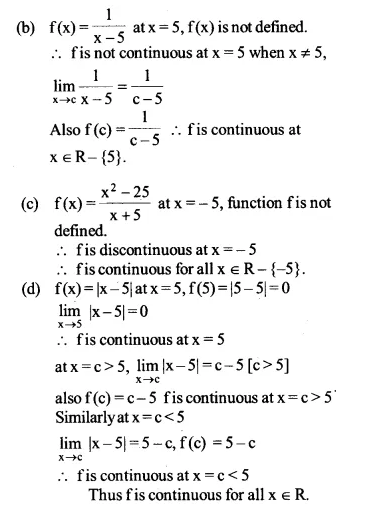
Ex 5.1 Class 12 Maths Question 4.
Prove that the function f (x) = xn is continuous at x = n, where n is a positive integer.
Solution.
f (x) = xn is a polynomial which is continuous for all x ∈ R.
Hence f is continuous at x = n, n ∈ N.
Ex 5.1 Class 12 Maths Question 5.
Is the function f defined by \(f(x)=\begin{cases} x,ifx\le 1 \\ 5,ifx>1 \end{cases}\) continuous at x = 0? At x = 1? At x = 2?
Solution.
(i) At x = 0
limx–>0- f(x) = limx–>0- x = 0 and
limx–>0+ f(x) = limx–>0+ x = 0 => f(0) = 0
∴ f is continuous at x = 0
(ii) At x = 1
limx–>1- f(x) = limx–>1- (x) = 1 and
limx–>1+ f(x) = limx–>1+(x) = 5
∴ limx–>1- f(x) ≠ limx–>1+ f(x)
∴ f is discontinuous at x = 1
(iii) At x = 2
limx–>2 f(x) = 5, f(2) = 5
∴ f is continuous at x = 2
Find all points of discontinuity off, where f is defined by
Ex 5.1 Class 12 Maths Question 6.
\(f(x)=\begin{cases} 2x+3,if\quad x\le 2 \\ 2x-3,if\quad x>2 \end{cases}\)
Solution.
\(f(x)=\begin{cases} 2x+3,if\quad x\le 2 \\ 2x-3,if\quad x>2 \end{cases}\) at x≠2
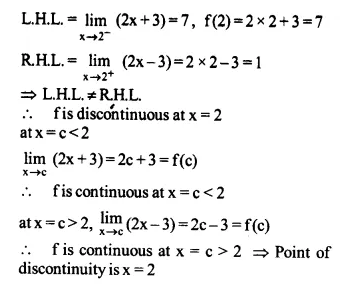
Ex 5.1 Class 12 Maths Question 7.
\(f(x)=\begin{cases} |x|+3,if\quad x\le -3 \\ -2x,if\quad -3<x<3 \\ 6x+2,if\quad x\ge 3 \end{cases}\)
Solution.
\(f(x)=\begin{cases} |x|+3,if\quad x\le -3 \\ -2x,if\quad -3<x<3 \\ 6x+2,if\quad x\ge 3 \end{cases}\)

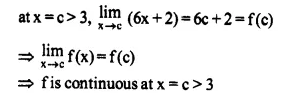
Ex 5.1 Class 12 Maths Question 8.
Test the continuity of the function f (x) at x = 0
\(f(x)=\begin{cases} \frac { |x| }{ x } ;x\neq 0 \\ 0;x=0 \end{cases}\)
Solution.
We have;
(LHL at x=0)
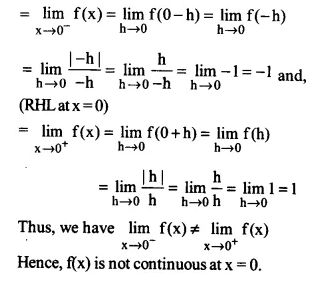
Ex 5.1 Class 12 Maths Question 9.
\(f(x)=\begin{cases} \frac { x }{ |x| } ;if\quad x<0 \\ -1,if\quad x\ge 0 \end{cases}\)
Solution.
\(f(x)=\begin{cases} \frac { x }{ |x| } ;if\quad x<0 \\ -1,if\quad x\ge 0 \end{cases}\)
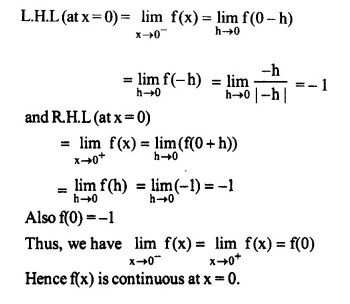
Ex 5.1 Class 12 Maths Question 10.
\(f(x)=\begin{cases} x+1,if\quad x\ge 1 \\ { x }^{ 2 }+1,if\quad x<1 \end{cases}\)
Solution.
\(f(x)=\begin{cases} x+1,if\quad x\ge 1 \\ { x }^{ 2 }+1,if\quad x<1 \end{cases}\)
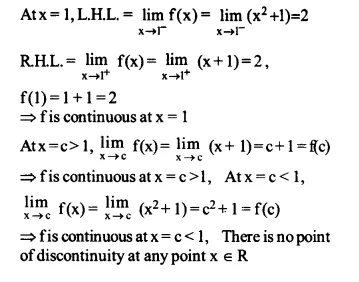
Ex 5.1 Class 12 Maths Question 11.
\(f(x)=\begin{cases} { x }^{ 3 }-3,if\quad x\le 2 \\ { x }^{ 2 }+1,if\quad x>2 \end{cases} \)
Solution.
\(f(x)=\begin{cases} { x }^{ 3 }-3,if\quad x\le 2 \\ { x }^{ 2 }+1,if\quad x>2 \end{cases} \)
At x = 2, L.H.L. limx–>2- (x³ – 3) = 8 – 3 = 5
R.H.L. = limx–>2+ (x² + 1) = 4 + 1 = 5
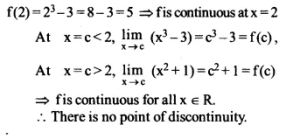
Ex 5.1 Class 12 Maths Question 12.
\(f(x)=\begin{cases} { x }^{ 10 }-1,if\quad x\le 1 \\ { x }^{ 2 },if\quad x>1 \end{cases} \)
Solution.
\(f(x)=\begin{cases} { x }^{ 10 }-1,if\quad x\le 1 \\ { x }^{ 2 },if\quad x>1 \end{cases} \)
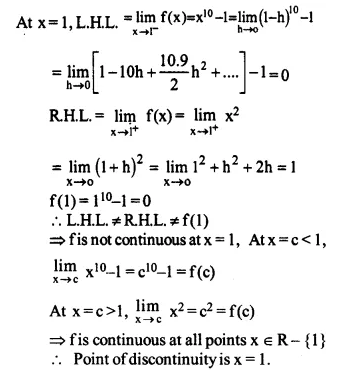
Ex 5.1 Class 12 Maths Question 13.
Is the function defined by \(f(x)=\begin{cases} x+5,if\quad x\le 1 \\ x-5,if\quad x>1 \end{cases} \) a continuous function?
Solution.
At x = 1,L.H.L.= limx–>1- f(x) = limx–>1- (x + 5) = 6,
R.HL. = limx–>1+ f(x) = limx–>1+ (x – 5) = – 4
f(1) = 1 + 5 = 6,
f(1) = L.H.L. ≠ R.H.L.
=> f is not continuous at x = 1
At x = c < 1, limx–>c (x + 5) = c + 5 = f(c)
At x = c > 1, limx–>c (x – 5) = c – 5 = f(c)
∴ f is continuous at all points x ∈ R except x = 1.
Discuss the continuity of the function f, where f is defined by
Ex 5.1 Class 12 Maths Question 14.
\(f(x)=\begin{cases} 3,if\quad 0\le x\le 1 \\ 4,if\quad 1<x<3 \\ 5,if\quad 3\le x\le 10 \end{cases}\)
Solution.
\(f(x)=\begin{cases} 3,if\quad 0\le x\le 1 \\ 4,if\quad 1<x<3 \\ 5,if\quad 3\le x\le 10 \end{cases}\)
In the interval 0 ≤ x ≤ 1,f(x) = 3; f is continuous in this interval.
At x = 1,L.H.L. = lim f(x) = 3,
R.H.L. = limx–>1+ f(x) = 4 => f is discontinuous at
x = 1
At x = 3, L.H.L. = limx–>3- f(x)=4,
R.H.L. = limx–>3+ f(x) = 5 => f is discontinuous at
x = 3
=> f is not continuous at x = 1 and x = 3.
Ex 5.1 Class 12 Maths Question 15.
\(f(x)=\begin{cases} 2x,if\quad x<0 \\ 0,if\quad 0\le x\le 1 \\ 4x,if\quad x>1 \end{cases}\)
Solution.
\(f(x)=\begin{cases} 2x,if\quad x<0 \\ 0,if\quad 0\le x\le 1 \\ 4x,if\quad x>1 \end{cases}\)
At x = 0, L.H.L. = limx–>0- 2x = 0 ,
R.H.L. = limx–>0+ (0)= 0 , f(0) = 0
=> f is continuous at x = 0
At x = 1, L.H.L. = limx–>1- (0) = 0,
R.H.L. = limx–>1+ 4x = 4
f(1) = 0, f(1) = L.H.L.≠R.H.L.
∴ f is not continuous at x = 1
when x < 0 f (x) = 2x, being a polynomial, it is
continuous at all points x < 0. when x > 1. f (x) = 4x being a polynomial, it is
continuous at all points x > 1.
when 0 ≤ x ≤ 1, f (x) = 0 is a continuous function
the point of discontinuity is x = 1.
Ex 5.1 Class 12 Maths Question 16.
\(f(x)=\begin{cases} -2,if\quad x\le -1 \\ 2x,if\quad -1<x\le 1 \\ 2,if\quad x>1 \end{cases}\)
Solution.
\(f(x)=\begin{cases} -2,if\quad x\le -1 \\ 2x,if\quad -1<x\le 1 \\ 2,if\quad x>1 \end{cases}\)
At x = – 1,L.H.L. = limx–>1- f(x) = – 2, f(-1) = – 2,
R.H.L. = limx–>1+ f(x) = – 2
=> f is continuous at x = – 1
At x= 1, L.H.L. = limx–>1- f(x) = 2,f(1) = 2
∴ f is continuous at x = 1,
R.H.L. = limx–>1+ f(x) = 2
Hence, f is continuous function.
Ex 5.1 Class 12 Maths Question 17.
Find the relationship between a and b so that the function f defined by
\(f(x)=\begin{cases} ax+1,if\quad x\le 3 \\ bx+3,if\quad x>3 \end{cases}\)
is continuous at x = 3
Solution.
At x = 3, L.H.L. = limx–>3- (ax+1) = 3a+1 ,
f(3) = 3a + 1, R.H.L. = limx–>3+ (bx+3) = 3b+3
f is continuous ifL.H.L. = R.H.L. = f(3)
3a + 1 = 3b + 3 or 3(a – b) = 2
a – b = \(\\ \frac { 2 }{ 3 } \) or a = b + \(\\ \frac { 2 }{ 3 } \), for any arbitrary value of b.
Therefore the value of a corresponding to the value of b.
Ex 5.1 Class 12 Maths Question 18.
For what value of λ is the function defined by
\(f(x)=\begin{cases} \lambda ({ x }^{ 2 }-2x),if\quad x\le 0 \\ 4x+1,if\quad x>0 \end{cases} \)
continuous at x = 0? What about continuity at x = 1?
Solution.
At x = 0, L.H.L. = limx–>0- λ (x² – 2x) = 0 ,
R.H.L. = limx–>0+ (4x+ 1) = 1, f(0)=0
f (0) = L.H.L. ≠ R.H.L.
=> f is not continuous at x = 0,
whatever value of λ ∈ R may be
At x = 1, limx–>1 f(x) = limx–>1 (4x + l) = f(1)
=> f is not continuous at x = 0 for any value of λ but f is continuous at x = 1 for all values of λ.
Ex 5.1 Class 12 Maths Question 19.
Show that the function defined by g (x) = x – [x] is discontinuous at all integral points. Here [x] denotes the greatest integer less than or equal to x.
Solution.
Let c be an integer, [c – h] = c – 1, [c + h] = c, [c] = c, g(x) = x – [x].
At x = c, limx–>c- (x – [x]) = limh–>0 [(c – h) – (c – 1)]
= limh–>0 (c – h – (c – 1)) = 1[∵ [c – h] = c – 1]
R.H.L. = limx–>c+ (x – [x])= limh–>0 (c + h – [c + h])
= limh–>0 [c + h – c] = 0
f(c) = c – [c] = 0,
Thus L.H.L. ≠ R.H.L. = f (c) => f is not continuous at integral points.
Ex 5.1 Class 12 Maths Question 20.
Is the function defined by f (x) = x² – sin x + 5 continuous at x = π?
Solution.
Let f(x) = x² – sinx + 5,

Ex 5.1 Class 12 Maths Question 21.
Discuss the continuity of the following functions:
(a) f (x) = sin x + cos x
(b) f (x) = sin x – cos x
(c) f (x) = sin x · cos x
Solution.
(a) f(x) = sinx + cosx
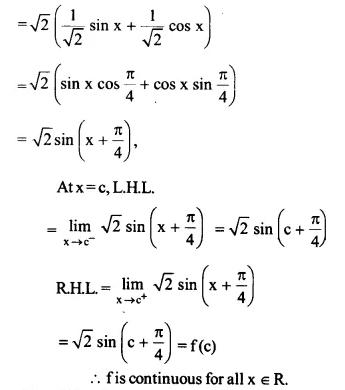
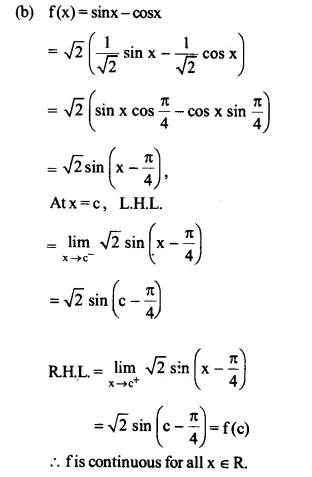
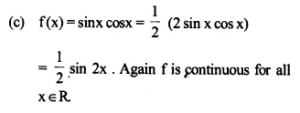
Ex 5.1 Class 12 Maths Question 22.
Discuss the continuity of the cosine, cosecant, secant and cotangent functions.
Solution.
(a) Let f(x) = cosx
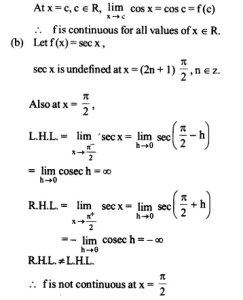
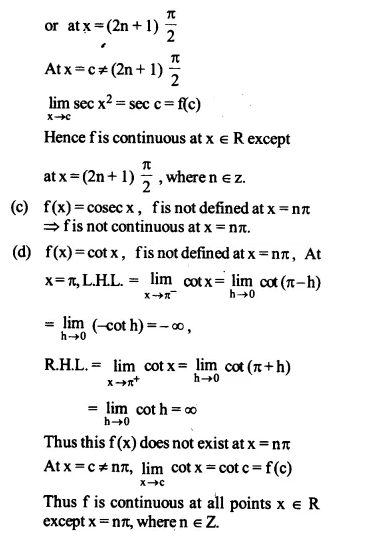
Ex 5.1 Class 12 Maths Question 23.
Find all points of discontinuity of f, where
\(f(x)=\begin{cases} \frac { sinx }{ x } ,if\quad x<0 \\ x+1,if\quad x\ge 0 \end{cases}\)
Solution.
At x = 0
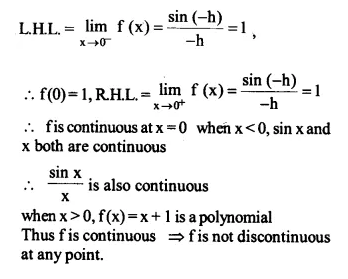
Ex 5.1 Class 12 Maths Question 24.
Determine if f defined by \(f(x)=\begin{cases} { x }^{ 2 }sin\frac { 1 }{ x } ,if\quad x\neq 0 \\ 0,if\quad x=0 \end{cases}\) is a continuous function?
Solution.
At x = 0
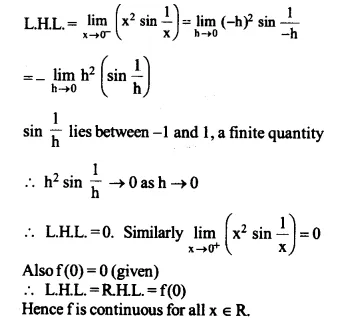
Ex 5.1 Class 12 Maths Question 25.
Examine the continuity of f, where f is defined by \(f(x)=\begin{cases} sinx-cosx,if\quad x\neq 0 \\ -1,if\quad x=0 \end{cases}\)
Solution.
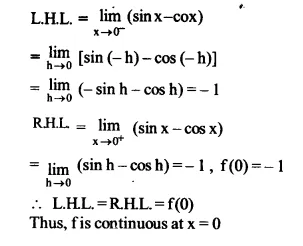
Find the values of k so that the function is continuous at the indicated point in Questions 26 to 29.
Ex 5.1 Class 12 Maths Question 26.
\(f(x)=\begin{cases} \frac { k\quad cosx }{ \pi -2x } ,\quad if\quad x\neq \frac { \pi }{ 2 } \quad at\quad x=\frac { \pi }{ 2 } \qquad \\ 3,if\quad x=\frac { \pi }{ 2 } \quad at\quad x=\frac { \pi }{ 2 } \end{cases} \)
Solution.
At x = \(\frac { \pi }{ 2 } \)
L.H.L = \(\underset { x\rightarrow { \left( \frac { \pi }{ 2 } \right) }^{ – } }{ lim } \frac { k\quad cosx }{ \pi -2x } \)
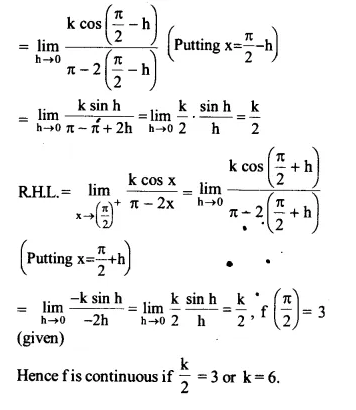
Ex 5.1 Class 12 Maths Question 27.
\(f(x)=\begin{cases} { kx }^{ 2 },if\quad x\le 2\quad at\quad x=2 \\ 3,if\quad x>2\quad at\quad x=2 \end{cases} \)
Solution.
\(f(x)=\begin{cases} { kx }^{ 2 },if\quad x\le 2\quad at\quad x=2 \\ 3,if\quad x>2\quad at\quad x=2 \end{cases} \)
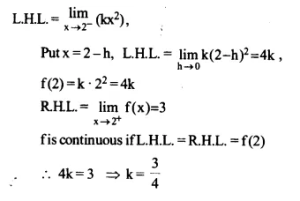
Ex 5.1 Class 12 Maths Question 28.
\(f(x)=\begin{cases} kx+1,if\quad x\le \pi \quad at\quad x=\pi \\ cosx,if\quad x>\pi \quad at\quad x=\pi \end{cases} \)
Solution.

Ex 5.1 Class 12 Maths Question 29.
\(f(x)=\begin{cases} kx+1,if\quad x\le 5\quad at\quad x=5 \\ 3x-5,if\quad x>5\quad at\quad x=5 \end{cases} \)
Solution.
\(f(x)=\begin{cases} kx+1,if\quad x\le 5\quad at\quad x=5 \\ 3x-5,if\quad x>5\quad at\quad x=5 \end{cases} \)
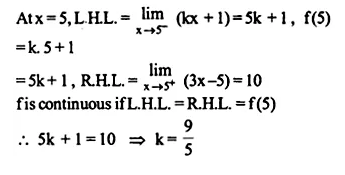
Ex 5.1 Class 12 Maths Question 30.
Find the values of a and b such that the function defined by
\(f(x)=\begin{cases} 5,if\quad x\le 2 \\ ax+b,if\quad 2<x<10 \\ 21,if\quad x\ge 10 \end{cases} \)
to is a continuous function.
Solution.

Ex 5.1 Class 12 Maths Question 31.
Show that the function defined by f(x)=cos (x²) is a continuous function.
Solution.
Now, f (x) = cosx², let g (x)=cosx and h (x) x²
∴ goh(x) = g (h (x)) = cos x²
Now g and h both are continuous ∀ x ∈ R.
f (x) = goh (x) = cos x² is also continuous at all x ∈ R.
Ex 5.1 Class 12 Maths Question 32.
Show that the function defined by f (x) = |cos x| is a continuous function.
Solution.
Let g(x) =|x|and h (x) = cos x, f(x) = goh(x) = g (h (x)) = g (cosx) = |cos x |
Now g (x) = |x| and h (x) = cos x both are continuous for all values of x ∈ R.
∴ (goh) (x) is also continuous.
Hence, f (x) = goh (x) = |cos x| is continuous for all values of x ∈ R.
Ex 5.1 Class 12 Maths Question 33.
Examine that sin |x| is a continuous function.
Solution.
Let g (x) = sin x, h (x) = |x|, goh (x) = g (h(x))
= g(|x|) = sin|x| = f(x)
Now g (x) = sin x and h (x) = |x| both are continuous for all x ∈ R.
∴f (x) = goh (x) = sin |x| is continuous at all x ∈ R.
Ex 5.1 Class 12 Maths Question 34.
Find all the points of discontinuity of f defined by f(x) = |x|-|x+1|.
Solution.
f(x) = |x|-|x+1|, when x< – 1,
f(x) = -x-[-(x+1)] = – x + x + 1 = 1
when -1 ≤ x < 0, f(x) = – x – (x + 1) = – 2x – 1,
when x ≥ 0, f(x) = x – (x + 1) = – 1
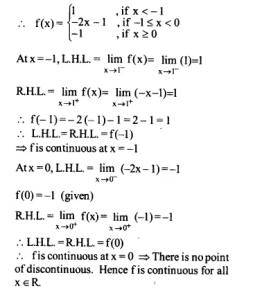
NCERT Solutions for Class 12 Maths Chapter 5 Continuity and Differentiability Exc 5.2
Differentiate the functions with respect to x in Questions 1 to 8.
<Ex 5.2 Class 12 Maths Question 1.
sin(x² + 5)
Solution.
Let y = sin(x2 + 5),
put x² + 5 = t
y = sint
t = x²+5
\(\frac { dy }{ dx } =\frac { dy }{ dt } .\frac { dt }{ dx } \)
\(\frac { dy }{ dx } =cost.\frac { dt }{ dx } =cos({ x }^{ 2 }+5)\frac { d }{ dx } ({ x }^{ 2 }+5)\)
= cos (x² + 5) × 2x
= 2x cos (x² + 5)
Ex 5.2 Class 12 Maths Question 2.
cos (sin x)
Solution.
let y = cos (sin x)
put sinx = t
∴ y = cost,
t = sinx
∴\(\frac { dy }{ dx } =-sin\quad t,\frac { dt }{ dx } =cos\quad x \)
\(\frac { dy }{ dx } =\frac { dy }{ dt } .\frac { dt }{ dx } =(-sint)\times cosx\)
Putting the value of t, \(\frac { dy }{ dx } =-sin(sinx)\times cosx\)
\(\frac { dy }{ dx } =-[sin(sinx)]cosx\)
Ex 5.2 Class 12 Maths Question 3.
sin(ax+b)
Solution.
let = sin(ax+b)
put ax+bx = t
∴ y = sint
t = ax+b
\(\frac { dy }{ dt } =cost,\frac { dt }{ dx } =\frac { d }{ dx } (ax+b)=a\)
\(Now\frac { dy }{ dx } =\frac { dy }{ dt } .\frac { dt }{ dx } =cost\times a=acos\quad t\)
\(\frac { dy }{ dx } =acos(ax+b)\)
Ex 5.2 Class 12 Maths Question 4.
sec(tan(√x))
Solution.
let y = sec(tan(√x))
by chain rule
\(\frac { dy }{ dx } =sec(tan\sqrt { x } )tan(tan\sqrt { x } )\frac { d }{ dx } (tan\sqrt { x } )\)
\(\frac { dy }{ dx } =sec(tan\sqrt { x } ).tan(tan\sqrt { x } ){ sec }^{ 2 }\sqrt { x } .\frac { 1 }{ 2\sqrt { x } } \)
Ex 5.2 Class 12 Maths Question 5.
\(\\ \frac { sin(ax+b) }{ cos(cx+d) } \)
Solution.
y = \(\\ \frac { sin(ax+b) }{ cos(cx+d) } \) = \(\\ \frac { v }{ u } \)
u = sin(ax+b)
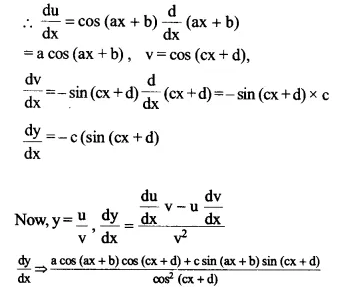
Ex 5.2 Class 12 Maths Question 6.
cos x³ . sin²(x5) = y(say)
Solution.
Let u = cos x³ and v = sin² x5,
put x³ = t
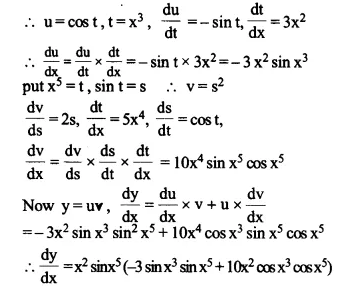
Ex 5.2 Class 12 Maths Question 7.
\(2\sqrt { cot({ x }^{ 2 }) } =y(say)\)
Solution.
\(2\sqrt { cot({ x }^{ 2 }) } =y(say)\)
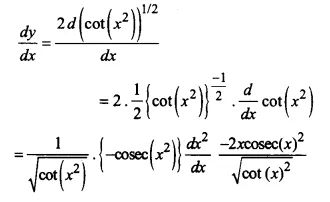
Ex 5.2 Class 12 Maths Question 8.
cos(√x) = y(say)
Solution.
cos(√x) = y(say)
\(\frac { dy }{ dx } =\frac { d }{ dx } cos\left( \sqrt { x } \right) =-sin\sqrt { x } .\frac { d\sqrt { x } }{ dx } \)
\(=-sin\sqrt { x } .\frac { 1 }{ 2 } { (x) }^{ -\frac { 1 }{ 2 } }=\frac { -sin\sqrt { x } }{ 2\sqrt { x } } \)
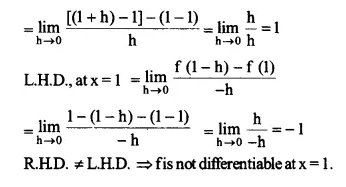
Ex 5.2 Class 12 Maths Question 9.
Prove that the function f given by f (x) = |x – 1|,x ∈ R is not differential at x = 1.
Solution.
The given function may be written as
\(f(x)=\begin{cases} x-1,\quad if\quad x\ge 1 \\ 1-x,\quad if\quad x<1 \end{cases} \)
\(R.H.D\quad at\quad x=1\quad =\underset { h\rightarrow 0 }{ lim } \frac { f(1+h)-f(1) }{ h } \)
Ex 5.2 Class 12 Maths Question 10.
Prove that the greatest integer function defined by f (x)=[x], 0 < x < 3 is not differential at x = 1 and x = 2.
Solution.
(i) At x = 1
\(R.H.D=\underset { h\rightarrow 0 }{ lim } \frac { f(1+h)-f(1) }{ h } \)

NCERT Solutions for Class 12 Maths Chapter 5 Continuity and Differentiability Exc 5.3
Find \(\\ \frac { dy }{ dx } \) in the following
<Ex 5.3 Class 12 Maths Question 1.
2x + 3y = sinx
Solution.
2x + 3y = sinx
Differentiating w.r.t x,
\(2+3\frac { dy }{ dx } =cosx \)
=>\(\frac { dy }{ dx } =\frac { 1 }{ 3 } (cosx-2)\)
Ex 5.3 Class 12 Maths Question 2.
2x + 3y = siny
Solution.
2x + 3y = siny
Differentiating w.r.t x,
\(2+3.\frac { dy }{ dx } =cosy\frac { dy }{ dx } \)
=>\(\frac { dy }{ dx } =\frac { 2 }{ cosy-3 } \)
Ex 5.3 Class 12 Maths Question 3.
ax + by² = cosy
Solution.
ax + by² = cosy
Differentiate w.r.t. x,
\(a+2\quad by\quad \frac { dy }{ dx } =-siny\frac { dy }{ dx } \)
=>\(or\quad (2b+siny)\frac { dy }{ dx } =-a=>\frac { dy }{ dx } =-\frac { a }{ 2b+siny } \)

Ex 5.3 Class 12 Maths Question 4.
xy + y² = tan x + y
Solution.
xy + y² = tanx + y
Differentiating w.r.t. x,
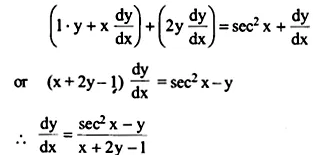
Ex 5.3 Class 12 Maths Question 5.
x² + xy + y² = 100
Solution.
x² + xy + xy = 100
Differentiating w.r.t. x,
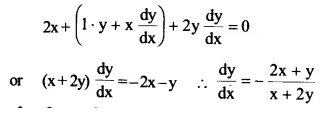
Ex 5.3 Class 12 Maths Question 6.
x³ + x²y + xy² + y³ = 81
Solution.
Given that
x³ + x²y + xy² + y³ = 81
Differentiating both sides we get
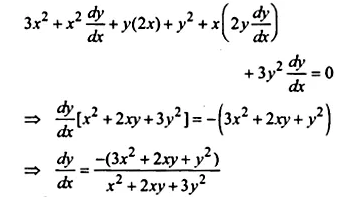
Ex 5.3 Class 12 Maths Question 7.
sin² y + cos xy = π
Solution.
Given that
sin² y + cos xy = π
Differentiating both sides we get
\(2\quad sin\quad y\frac { d\quad siny }{ dx } +(-sinxy)\frac { d(xy) }{ dx } =0\)

Ex 5.3 Class 12 Maths Question 8.
sin²x + cos²y = 1
Solution.
Given that
sin²x + cos²y = 1
Differentiating both sides, we get
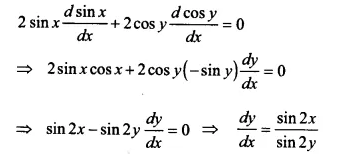
Ex 5.3 Class 12 Maths Question 9.
\(y={ sin }^{ -1 }\left( \frac { 2x }{ { 1+x }^{ 2 } } \right) \)
Solution.
\(y={ sin }^{ -1 }\left( \frac { 2x }{ { 1+x }^{ 2 } } \right) \)
put x = tanθ
\(y={ sin }^{ -1 }\left( \frac { 2tan\theta }{ { 1+tan }^{ 2 }\theta } \right) ={ sin }^{ -1 }(sin2\theta )=2\theta \)
\(y={ 2sin }^{ -1 }x\quad \therefore \frac { dy }{ dx } =\frac { 2 }{ 1+{ x }^{ 2 } } \)
Ex 5.3 Class 12 Maths Question 10.
\(y={ tan }^{ -1 }\left( \frac { { 3x-x }^{ 3 } }{ { 1-3x }^{ 2 } } \right) ,-\frac { 1 }{ \sqrt { 3 } } <x<\frac { 1 }{ \sqrt { 3 } } \)
Solution.
\(y={ tan }^{ -1 }\left( \frac { { 3x-x }^{ 3 } }{ { 1-3x }^{ 2 } } \right) \)
put x = tanθ

Ex 5.3 Class 12 Maths Question 11.
\(y={ cos }^{ -1 }\left( \frac { 1-{ x }^{ 2 } }{ 1+{ x }^{ 2 } } \right) ,0<x<1 \)
Solution.
\(y={ cos }^{ -1 }\left( \frac { 1-{ x }^{ 2 } }{ 1+{ x }^{ 2 } } \right) ,0<x<1 \)
put x = tanθ
\(y={ cos }^{ -1 }\left( \frac { 1-tan^{ 2 }\quad \theta }{ 1+{ tan }^{ 2 }\quad \theta } \right) ={ cos }^{ -1 }(cos2\theta )=2\theta \)
\(y={ 2tan }^{ -1 }x\quad \therefore \frac { dy }{ dx } =\frac { 2 }{ 1+{ x }^{ 2 } } \)
Ex 5.3 Class 12 Maths Question 12.
\(y={ sin }^{ -1 }\left( \frac { 1-{ x }^{ 2 } }{ 1+{ x }^{ 2 } } \right) ,0<x<1\)
Solution.
\(y={ sin }^{ -1 }\left( \frac { 1-{ x }^{ 2 } }{ 1+{ x }^{ 2 } } \right) ,0<x<1\)
put x = tanθ
we get
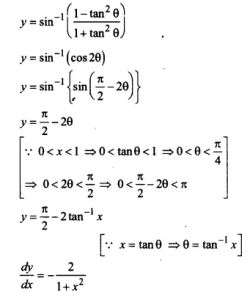
Ex 5.3 Class 12 Maths Question 13.
\(y={ cos }^{ -1 }\left( \frac { 2x }{ 1+{ x }^{ 2 } } \right) ,-1<x<1 \)
Solution.
\(y={ cos }^{ -1 }\left( \frac { 2x }{ 1+{ x }^{ 2 } } \right) ,-1<x<1 \)
put x = tanθ
we get
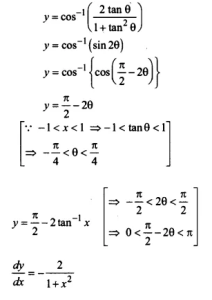
Ex 5.3 Class 12 Maths Question 14.
\(y=sin^{ -1 }\left( 2x\sqrt { 1-{ x }^{ 2 } } \right) ,-\frac { 1 }{ \sqrt { 2 } } <x<\frac { 1 }{ \sqrt { 2 } } \)
Solution.
\(y=sin^{ -1 }\left( 2x\sqrt { 1-{ x }^{ 2 } } \right) ,-\frac { 1 }{ \sqrt { 2 } } <x<\frac { 1 }{ \sqrt { 2 } } \)
put x = tanθ
we get
\(y=sin^{ -1 }\left( 2sin\quad \theta \sqrt { 1-{ x }^{ 2 } } \right) \)
\(y=sin^{ -1 }\left( 2sin\theta \quad cos\theta \right) \quad ={ sin }^{ -1 }(sin2\theta )\quad =2\theta \)
\(y=2sin^{ -1 }x\quad \therefore \frac { dy }{ dx } =\frac { 2 }{ \sqrt { { 1-x }^{ 2 } } } \)
Ex 5.3 Class 12 Maths Question 15.
\(y=sin^{ -1 }\left( \frac { 1 }{ { 2x }^{ 2 }-1 } \right) ,0<x<\frac { 1 }{ \sqrt { 2 } } \)
Solution.
\(y=sin^{ -1 }\left( \frac { 1 }{ { 2x }^{ 2 }-1 } \right) ,0<x<\frac { 1 }{ \sqrt { 2 } } \)
put x = tanθ
we get
\(y=sec^{ -1 }\left( \frac { 1 }{ { 2cos }^{ 2 }\theta -1 } \right) ={ sec }^{ -1 }\left( \frac { 1 }{ cos2\theta } \right) \)
\(y=sec^{ -1 }(sec2\theta )=2\theta ,\quad y=2{ cos }^{ -1 }x \)
\(\therefore \frac { dy }{ dx } =\frac { -2 }{ \sqrt { { 1-x }^{ 2 } } } \)
NCERT Solutions for Class 12 Maths Chapter 5 Continuity and Differentiability Exc 5.4
Differentiate the following w.r.t.x:
<Ex 5.4 Class 12 Maths Question 1.
\(\frac { { e }^{ x } }{ sinx } \)
Solution.
\(y=\frac { { e }^{ x } }{ sinx } \)
\(for\quad y=\frac { u }{ v } ,\)
\(\frac { dy }{ dx } =\frac { { e }^{ x }{ sin }x-{ e }^{ x }cosx }{ { sin }^{ 2 }x } \)
\(or\frac { dy }{ dx } =\frac { { e }^{ x }{ sin }x-{ e }^{ x }cosx }{ { sin }^{ 2 }x } ,where\quad x\neq n\pi ,x\in z \)
Ex 5.4 Class 12 Maths Question 2.
\({ e }^{ { sin }^{ -1 }x }\)
Solution.
\({ e }^{ { sin }^{ -1 }x }\)
\(y={ e }^{ { sin }^{ -1 }x }\)
x=sint
\(\therefore y={ e }^{ t },\frac { dt }{ dx } =\frac { 1 }{ \sqrt { 1-{ x }^{ 2 } } } ,\frac { dy }{ dt } ={ e }^{ t }\)
\(\therefore \frac { dy }{ dx } =\frac { dy }{ dt } .\frac { dt }{ dx } ={ e }^{ t }.\frac { 1 }{ \sqrt { { 1- }x^{ 2 } } } =\frac { { e }^{ { sin }^{ -1 }x } }{ \sqrt { 1-{ x }^{ 2 } } } \)
Ex 5.4 Class 12 Maths Question 3.
\({ e }^{ { x }^{ 3 } }=y \)
Solution.
\({ e }^{ { x }^{ 3 } }=y \)
\(Put\quad { x }^{ 3 }=t\quad \therefore \quad y={ e }^{ t },\frac { dy }{ dt } ={ e }^{ t },\frac { dt }{ dx } ={ 3x }^{ 2 } \)
\(\therefore \frac { dy }{ dx } =\frac { dy }{ dt } \times \frac { dt }{ dx } ={ e }^{ t }\times { 3x }^{ 2 }={ 3x }^{ 2 }{ e }^{ { x }^{ 3 } }\)
Ex 5.4 Class 12 Maths Question 4.
\(sin\left( { tan }^{ -1 }{ e }^{ -x } \right) =y\)
Solution.
\(sin\left( { tan }^{ -1 }{ e }^{ -x } \right) =y\)
\(\frac { dy }{ dx } =cos\left( { tan }^{ -1 }{ e }^{ -x } \right) \frac { d }{ dx } \left( { tan }^{ -1 }{ e }^{ -x } \right) \)
\(=cos\left( { tan }^{ -1 }{ e }^{ -x } \right) \frac { 1 }{ 1+{ e }^{ -2x } } \frac { d }{ dx } \left( { e }^{ -x } \right) \)
\(=-cos\left( { tan }^{ -1 }{ e }^{ -x } \right) \frac { 1 }{ 1+{ e }^{ -2x } } .\left( { e }^{ -x } \right) \)
Ex 5.4 Class 12 Maths Question 5.
\(log(cos\quad { e }^{ x })=y \)
Solution.
\(\frac { dy }{ dx } =\frac { 1 }{ cos\quad { e }^{ x } } \left( -sin{ e }^{ x } \right) .{ e }^{ x }\quad =-tan\left( { e }^{ x } \right) \)
Ex 5.4 Class 12 Maths Question 6.
\({ e }^{ x }+{ e }^{ { x }^{ 2 } }+\)…\(+{ e }^{ { x }^{ 5 } }=y(say)\)
Solution.
\(let\quad u={ e }^{ { x }^{ n } },put\quad { x }^{ n }=t,u={ e }^{ t },t={ x }^{ n }\)
\({ e }^{ x }+{ e }^{ { x }^{ 2 } }+\)…\(+{ e }^{ { x }^{ 5 } }=y(say)\)
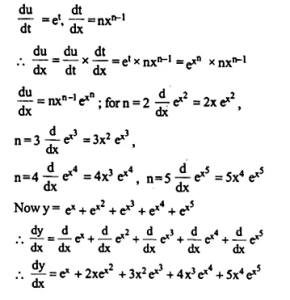
Ex 5.4 Class 12 Maths Question 7.
\(\sqrt { { e }^{ \sqrt { x } } } ,x>0\)
Solution.
y = \(\sqrt { { e }^{ \sqrt { x } } } ,x>0\)
\(y=\sqrt { { e }^{ \sqrt { x } } } ,let\quad y=\sqrt { s } ,s={ e }^{ t },t=\sqrt { x } \)
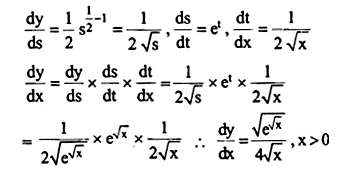
Ex 5.4 Class 12 Maths Question 8.
log(log x),x>1
Solution.
y = log(log x),
put y = log t, t = log x,
differentiating

Ex 5.4 Class 12 Maths Question 9.
\(\frac { cosx }{ logx } =y(say),x>0 \)
Solution.
let \(y=\frac { cosx }{ logx } \)
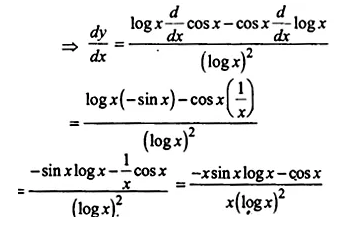
Ex 5.4 Class 12 Maths Question 10.
cos(log x+ex),x>0
Solution.
y = cos(log x+ex),x>0
put y = cos t,t = log x+ex
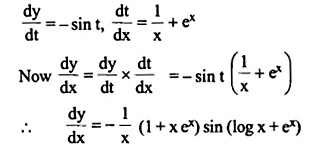
NCERT Solutions for Class 12 Maths Chapter 5 Continuity and Differentiability Exc 5.5
Differentiate the functions given in Questions 1 to 11 w.r.to x
<Ex 5.5 Class 12 Maths Question 1.
cos x. cos 2x. cos 3x
Solution.
Let y = cos x. cos 2x . cos 3x,
Taking log on both sides,
log y = log (cos x. cos 2x. cos 3x)
log y = log cos x + log cos 2x + log cos 3x,
Differentiating w.r.t. x, we get
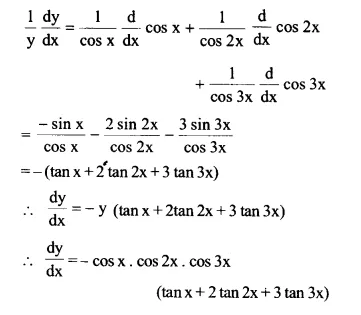
Ex 5.5 Class 12 Maths Question 2.
\(\sqrt { \frac { (x-1)(x-2) }{ (x-3)(x-4)(x-5) } } \)
Solution.
\(y=\sqrt { \frac { (x-1)(x-2) }{ (x-3)(x-4)(x-5) } } \)
taking log on both sides
log y = log \(\sqrt { \frac { (x-1)(x-2) }{ (x-3)(x-4)(x-5) } } \)
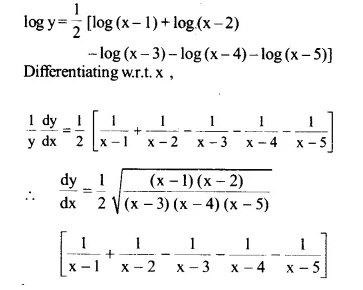
Ex 5.5 Class 12 Maths Question 3.
(log x)cosx
Solution.
let y = (log x)cosx
Taking log on both sides,
log y = log (log x)cosx
log y = cos x log (log x),
Differentiating w.r.t. x,
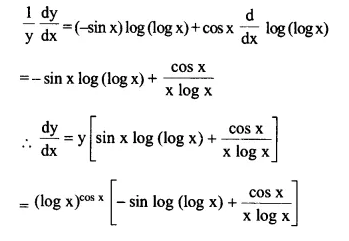
Ex 5.5 Class 12 Maths Question 4.
x – 2sinx
Solution.
let y = x – 2sinx,
y = u – v
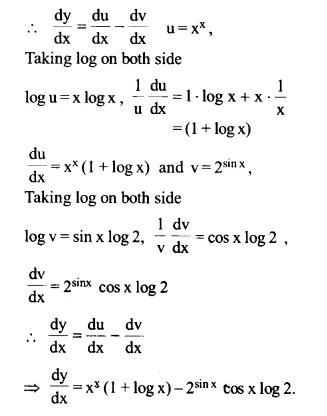
Ex 5.5 Class 12 Maths Question 5.
(x+3)2.(x + 4)3.(x + 5)4
Solution.
let y = (x + 3)2.(x + 4)3.(x + 5)4
Taking log on both side,
logy = log [(x + 3)2 • (x + 4)3 • (x + 5)4]
= log (x + 3)2 + log (x + 4)3 + log (x + 5)4
log y = 2 log (x + 3) + 3 log (x + 4) + 4 log (x + 5)
Differentiating w.r.t. x, we get
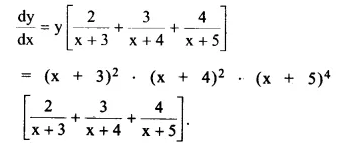
Ex 5.5 Class 12 Maths Question 6.
\({ \left( x+\frac { 1 }{ x } \right) }^{ x }+{ x }^{ \left( 1+\frac { 1 }{ x } \right) }\)
Solution.
let \(y={ \left( x+\frac { 1 }{ x } \right) }^{ x }+{ x }^{ \left( 1+\frac { 1 }{ x } \right) }\)
let \(u={ \left( x+\frac { 1 }{ x } \right) }^{ x }and\quad v={ x }^{ \left( 1+\frac { 1 }{ x } \right) }\)
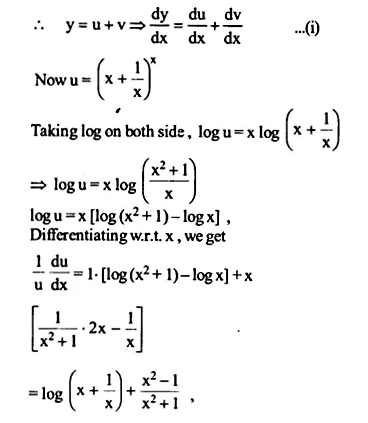
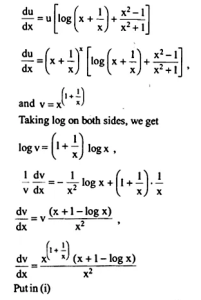
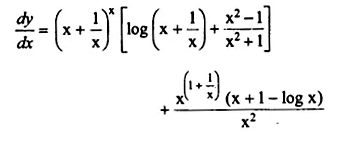
Ex 5.5 Class 12 Maths Question 7.
(log x)x + xlogx
Solution.
let y = (log x)x + xlogx = u+v
where u = (log x)x
∴ log u = x log(log x)
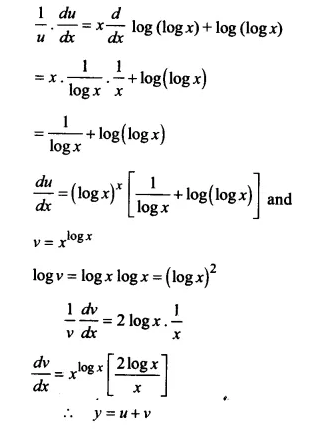
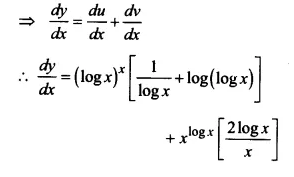
Ex 5.5 Class 12 Maths Question 8.
(sin x)x+sin-1 √x
Solution.
Let y = (sin x)x + sin-1 √x
let u = (sin x)x, v = sin-1 √x

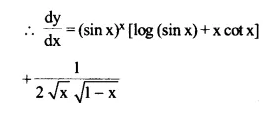
Ex 5.5 Class 12 Maths Question 9.
xsinx + (sin x)cosx
Solution.
let y = xsinx + (sin x)cosx = u+v
where u = xsinx
log u = sin x log x
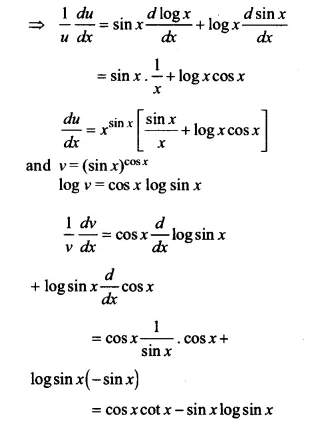

Ex 5.5 Class 12 Maths Question 10.
\({ x }^{ x\quad cosx }+\frac { { x }^{ 2 }+1 }{ { x }^{ 2 }-1 } \)
Solution.
\(y={ x }^{ x\quad cosx }+\frac { { x }^{ 2 }+1 }{ { x }^{ 2 }-1 } \)
y = u + v
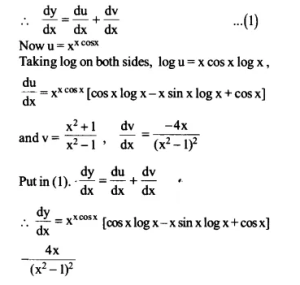
Ex 5.5 Class 12 Maths Question 11.
\({ (x\quad cosx) }^{ x }+{ (x\quad sinx) }^{ \frac { 1 }{ x } }\)
Solution.
\(y={ (x\quad cosx) }^{ x }+{ (x\quad sinx) }^{ \frac { 1 }{ x } }\)
Let u = (x cosx)x
logu = x log(x cosx)
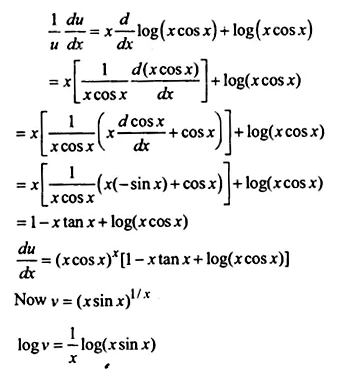

Find \(\\ \frac { dy }{ dx } \) of the functions given in Questions 12 to 15.
Ex 5.5 Class 12 Maths Question 12.
xy + yx = 1
Solution.
xy + yx = 1
let u = xy and v = yx
∴ u + v = 1,
\(\frac { du }{ dx } +\frac { dv }{ dx }=0\)
Now u = x

Ex 5.5 Class 12 Maths Question 13.
yx = xy
Solution.
y = x
x logy = y logx
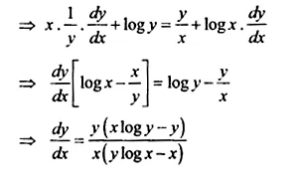
Ex 5.5 Class 12 Maths Question 14.
(cos x)y = (cos y)x
Solution.
We have
(cos x)y = (cos y)x
=> y log (cosx) = x log (cosy)
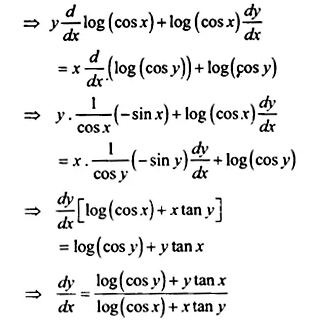
Ex 5.5 Class 12 Maths Question 15.
xy = e(x-y)
Solution.
log(xy) = log e(x-y)
=> log(xy) = x – y
=> logx + logy = x – y
\(=>\frac { 1 }{ x } +\frac { 1 }{ y } \frac { dy }{ dx } =1-\frac { dy }{ dx } =>\frac { dy }{ dx } =\frac { y(x-1) }{ x(y+1) } \)
Ex 5.5 Class 12 Maths Question 16.
Find the derivative of the function given by f (x) = (1 + x) (1 + x2) (1 + x4) (1 + x8) and hence find f'(1).
Solution.
Let f(x) = y = (1 + x)(1 + x2)(1 + x4)(1 + x8)
Taking log both sides, we get
logy = log [(1 + x)(1 + x2)(1 + x4)(1 + x8)]
logy = log(1 + x) + log (1 + x2) + log(1 + x4) + log(1 + x8)
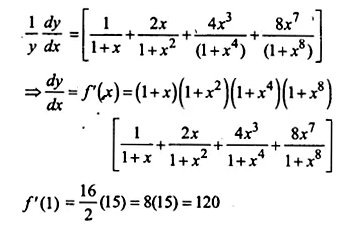
Ex 5.5 Class 12 Maths Question 17.
Differentiate (x2 – 5x + 8) (x3 + 7x + 9) in three ways mentioned below:
(i) by using product rule
(ii) by expanding the product to obtain a single polynomial.
(iii) by logarithmic differentiation.
Do they all give the same answer?
Solution.
(i) By using product rule
f’ = (x2 – 5x + 8) (3x2 + 7) + (x3 + 7x + 9) (2x – 5)
f = 5x4 – 20x3 + 45x2 – 52x + 11.
(ii) By expanding the product to obtain a single polynomial, we get
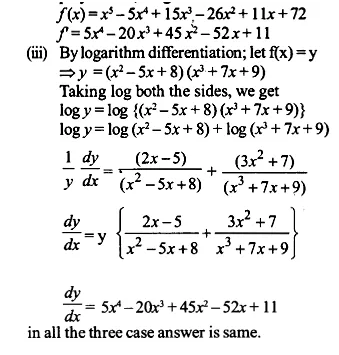
Ex 5.5 Class 12 Maths Question 18.
If u, v and w are functions of w then show that
\(\frac { d }{ dx } (u.v.w)=\frac { du }{ dx } v.w+u.\frac { dv }{ dx } .w+u.v\frac { dw }{ dx } \)
in two ways-first by repeated application of product rule, second by logarithmic differentiation.
Solution.
Let y = u.v.w
=> y = u. (vw)
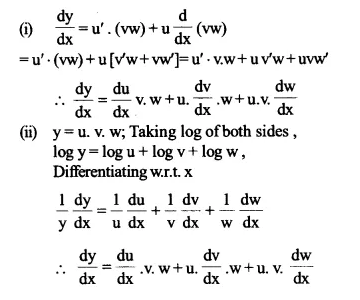
NCERT Solutions for Class 12 Maths Chapter 5 Continuity and Differentiability Exc 5.6
If x and y are connected parametrically by the equations given in Questions 1 to 10, without eliminating the parameter. Find \(\\ \frac { dy }{ dx } \).
<Ex 5.6 Class 12 Maths Question 1.
x = 2at², y = at4
Solution.
\(\frac { dx }{ dt } =4at,\frac { dy }{ dt } ={ 4at }^{ 3 }\quad \therefore \frac { dy }{ dx } =\frac { \frac { dy }{ dt } }{ \frac { dx }{ dt } } =\frac { { 4at }^{ 3 } }{ { 4at } } ={ t }^{ 2 }\)
Ex 5.6 Class 12 Maths Question 2.
x = a cosθ,y = b cosθ
Solution.
\(\frac { dx }{ d\theta } =-asin\theta ,\frac { dy }{ d\theta } =-sinb\quad sin\theta =>\frac { dy }{ dx } =\frac { b }{ a } \)
Ex 5.6 Class 12 Maths Question 3.
x = sin t, y = cos 2t
Solution.
\(\therefore \frac { dx }{ dt } =cos\quad t\quad and\frac { dy }{ dt } =-sin2t.2=-2sin2t\)
\(\frac { dy }{ dx } =\frac { -2sin2t }{ cost } =\frac { -2.2sintcost }{ cost } =-4sint\)
Ex 5.6 Class 12 Maths Question 4.
\(x=4t,y=\frac { 4 }{ t } \)
Solution.
\(\frac { dx }{ dt } =4;\frac { dy }{ dt } =\frac { -4 }{ { t }^{ 2 } } =>\frac { dy }{ dx } =\frac { -4 }{ { t }^{ 2 } } \times \frac { 1 }{ 4 } =\frac { -1 }{ { t }^{ 2 } } \)
Ex 5.6 Class 12 Maths Question 5.
x = cos θ – cos 2θ, y = sin θ – sin 2θ
Solution.
\(\frac { dx }{ d\theta } =-sin\theta -(-sin2\theta ).2=2sin2\theta -sin\theta \)
\(\frac { dy }{ d\theta } =cos\theta -2cos2\theta \quad \therefore \frac { dy }{ dx } =\frac { cos\theta -2cos2\theta }{ 2sin2\theta -sin\theta } \)
Ex 5.6 Class 12 Maths Question 6.
x = a(θ – sinθ), y = a(1 + cosθ)
Solution.
\(\frac { dx }{ d\theta } =a\left[ 1-cos\theta \right] \& \frac { dy }{ d\theta } =-asin\theta \)
\(\frac { dy }{ dx } =\frac { -asin\theta }{ a(1-cos\theta ) } =\frac { -2sin\frac { \theta }{ 2 } .cos\frac { \theta }{ 2 } }{ 2{ sin }^{ 2 }\frac { \theta }{ 2 } } =-cot\frac { \theta }{ 2 } \)
Ex 5.6 Class 12 Maths Question 7.
\(x=\frac { { sin }^{ 3 }t }{ \sqrt { cos2t } } \& y=\frac { { cos }^{ 3 }t }{ \sqrt { cos2t } } \)
Solution.
\(x=\frac { { sin }^{ 3 }t }{ \sqrt { cos2t } } \& y=\frac { { cos }^{ 3 }t }{ \sqrt { cos2t } } \)

Ex 5.6 Class 12 Maths Question 8.
\(x=a\left( cost+log\quad tan\frac { t }{ 2 } \right) ,y=a\quad sint \)
Solution.
\(x=a\left( cost+log\quad tan\frac { t }{ 2 } \right) ,y=a\quad sint \)
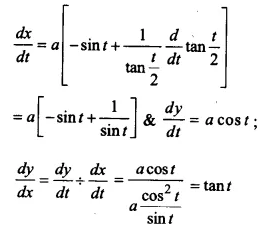
Ex 5.6 Class 12 Maths Question 9.
x = a sec θ,y = b tan θ
Solution.
x = a sec θ,y = b tan θ
\(\frac { dx }{ d\theta } =a\quad sec\theta \quad tan\theta \quad and\frac { dy }{ d\theta } =b{ sec }^{ 2 }\theta \)
\(\frac { dy }{ dx } =\frac { { bsec }^{ 2 }\theta }{ asec\theta tan\theta } \frac { b }{ a } cosec\theta \)
Ex 5.6 Class 12 Maths Question 10.
x = a(cosθ+θsinθ), y = a(sinθ-θcosθ)
Solution.
x = a(cosθ+θsinθ), y = a(sinθ-θcosθ)
\(\frac { dx }{ d\theta } =a\left[ -sin\theta +\theta .cos\theta +sin\theta \right] =a\theta cos\theta \)
\(\frac { dy }{ d\theta } =a\theta sin\theta =>\frac { dy }{ dx } =\frac { a\theta sin\theta }{ a\theta cos\theta } =tan\theta \)
Ex 5.6 Class 12 Maths Question 11.
If \(x=\sqrt { { a }^{ { sin }^{ -1 }t } } ,y=\sqrt { { a }^{ { cos }^{ -1 }t } } \) show that \(\frac { dy }{ dx } =-\frac { y }{ x } \)
Solution.
Given that
\(x=\sqrt { { a }^{ { sin }^{ -1 }t } } ,y=\sqrt { { a }^{ { cos }^{ -1 }t } } \)
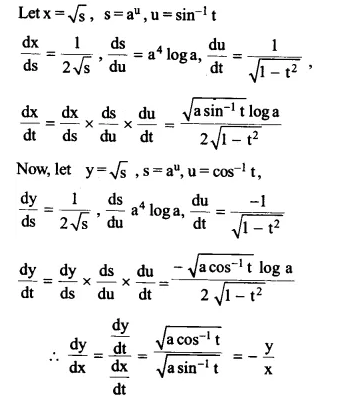
NCERT Solutions for Class 12 Maths Chapter 5 Continuity and Differentiability Exc 5.7
Find the second order derivatives of the functions given in Questions 1 to 10.
<Ex 5.7 Class 12 Maths Question 1.
x² + 3x + 2 = y(say)
Solution.
\(\frac { dy }{ dx } =2x+3\quad and\frac { { d }^{ 2 }y }{ { dx }^{ 2 } } =2\)
Ex 5.7 Class 12 Maths Question 2.
x20 = y(say)
Solution.
\(\frac { dy }{ dx } ={ 20 }x^{ 19 }\quad =>\frac { { d }^{ 2 }y }{ { dx }^{ 2 } } =20\times { 19x }^{ 18 }={ 380 }x^{ 18 }\qquad \)
Ex 5.7 Class 12 Maths Question 3.
x.cos x = y(say)
Solution.
\(\frac { dy }{ dx } =x(-sinx)+cosx.1,=-xsinx+cosx\)
\(\frac { { d }^{ 2 }y }{ { dx }^{ 2 } } =-xcosx-sinx-sinx=-xcosx-2sinx\)
Ex 5.7 Class 12 Maths Question 4.
log x = y (say)
Solution.
\(\frac { dy }{ dx } =\frac { 1 }{ x } =>\frac { { d }^{ 2 }y }{ { dx }^{ 2 } } =-\frac { 1 }{ { x }^{ 2 } } \)
Ex 5.7 Class 12 Maths Question 5.
x3 log x = y (say)
Solution.
x3 log x = y
\(=>\frac { dy }{ dx } ={ x }^{ 3 }.\frac { 1 }{ x } +logx\times { 3x }^{ 2 }={ x }^{ 2 }+{ 3x }^{ 2 }logx \)
\(\frac { { d }^{ 2 }y }{ { dx }^{ 2 } } =2x+{ 3x }^{ 2 }.\frac { 1 }{ x } +logx.6x=x(5+6logx) \)
Ex 5.7 Class 12 Maths Question 6.
ex sin5x = y
Solution.
ex sin5x = y
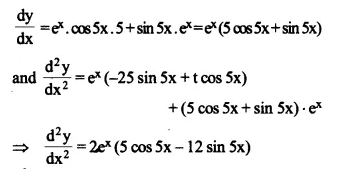
Ex 5.7 Class 12 Maths Question 7.
e6x cos3x = y
Solution.
e6x cos3x = y
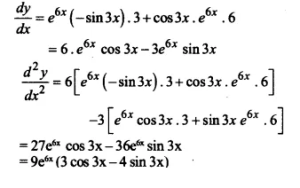
Ex 5.7 Class 12 Maths Question 8.
tan-1 x = y
Solution.
\(\frac { dy }{ dx } =\frac { 1 }{ 1+{ x }^{ 2 } } =>\frac { { d }^{ 2y } }{ { dx }^{ 2 } } =\frac { -2x }{ { ({ 1+x }^{ 2 }) }^{ 2 } } \)
Ex 5.7 Class 12 Maths Question 9.
log(logx) = y
Solution.
log(logx) = y
\(\frac { dy }{ dx } =\frac { 1 }{ logx } .\frac { 1 }{ x } \)
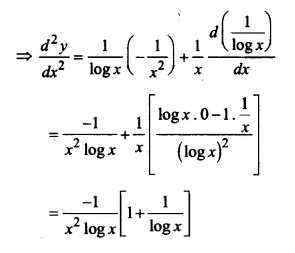
Ex 5.7 Class 12 Maths Question 10.
sin(log x) = y
Solution.
sin(log x) = y
\(\frac { dy }{ dx } =\frac { cos(logx) }{ x } \)
\(and\quad \frac { { d }^{ 2 }y }{ { dx }^{ 2 } } =\frac { x.\left[ -sin(logx) \right] .\frac { 1 }{ x } -cos(logx).1 }{ { x }^{ 2 } } \)
\(=\frac { \left[ sin(logx)+cos(logx) \right] }{ { x }^{ 2 } } \)
Ex 5.7 Class 12 Maths Question 11.
If y = 5 cosx – 3 sin x, prove that \(\frac { { d }^{ 2 }y }{ { dx }^{ 2 } } +y=0\)
Solution.
\(\frac { dy }{ dx } =-5sinx-3cosx\)
\(\frac { { d }^{ 2 }y }{ { dx }^{ 2 } } =-5cosx+3sinx=-y\)
\(\frac { { d }^{ 2 }y }{ { dx }^{ 2 } } +y=0\)
Hence proved
Ex 5.7 Class 12 Maths Question 12.
If y = cos-1 x, Find \(\frac { { d }^{ 2 }y }{ { dx }^{ 2 } } \) in terms of y alone.
Solution.
\(\frac { dy }{ dx } =-{ \left( { 1-x }^{ 2 } \right) }^{ -\frac { 1 }{ 2 } }\)
\(\frac { { d }^{ 2 }y }{ { dx }^{ 2 } } =\frac { -cosy }{ { \left( { sin }^{ 2 }y \right) }^{ \frac { 3 }{ 2 } } } =-coty\quad { cosec }^{ 2 }y\)
Ex 5.7 Class 12 Maths Question 13.
If y = 3 cos (log x) + 4 sin (log x), show that
\({ x }^{ 2 }{ y }_{ 2 }+{ xy }_{ 1 }+y=0\)
Solution.
Given that
y = 3 cos (log x) + 4 sin (log x)
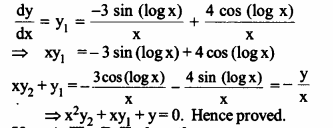
Ex 5.7 Class 12 Maths Question 14.
\(If\quad y=A{ e }^{ mx }+B{ e }^{ nx },\quad show\quad that\quad \frac { { d }^{ 2 }y }{ { dx }^{ 2 } } -(m+n)\frac { dy }{ dx } +mny=0\)
Solution.
Given that
\(\quad y=A{ e }^{ mx }+B{ e }^{ nx },\quad \)

Ex 5.7 Class 12 Maths Question 15.
If y = 500e7x + 600e-7x, show that \(\frac { { d }^{ 2 }y }{ { dx }^{ 2 } } =49y\).
Solution.
we have
y = 500e7x + 600e-7x
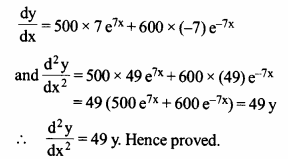
Ex 5.7 Class 12 Maths Question 16.
If ey(x+1) = 1,show that \(\frac { { d }^{ 2 }y }{ { dx }^{ 2 } } ={ \left( \frac { dy }{ dx } \right) }^{ 2 }\)
Solution.
\({ e }^{ y }(x+1)=1=>{ e }^{ y }=\frac { 1 }{ x+1 } \)
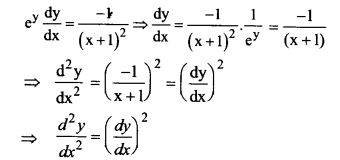
Ex 5.7 Class 12 Maths Question 17.
If y=(tan-1 x)² show that (x²+1)²y2+2x(x²+1)y1=2
Solution.
we have
y=(tan-1 x)²
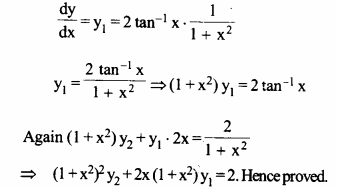
NCERT Solutions for Class 12 Maths Chapter 5 Continuity and Differentiability Exc 5.8
Ex 5.8 Class 12 Maths Question 1.
Verify Rolle’s theorem for the function
f(x) = x² + 2x – 8,x∈ [-4,2]
Solution.
Now f(x) = x² + 2x – 8 is a polynomial
∴ it is continuous and derivable in its domain x∈R.
Hence it is continuous in the interval [-4,2] and derivable in the interval (- 4,2)
f(-4) = (-4)² + 2(-4) – 8 = 16 – 8 – 8 = 0,
f(2) = 2² + 4 – 8 = 8 – 8 = 0
Conditions of Rolle’s theorem are satisfied.
f'(x) = 2x + 2
∴ f’ (c) = 2c + 2 = 0
or c = – 1, c = – 1 ∈ [-4,2]
Thus f’ (c) = 0 at c = – 1.
Ex 5.8 Class 12 Maths Question 2.
Examine if Rolle’s theorem is applicable to any of the following functions. Can you say some thing about the converse of Rolle’s theorem from these example?
(i) f(x) = [x] for x ∈ [5,9]
(ii) f (x) = [x] for x ∈ [-2,2]
(iii) f (x) = x² – 1 for x ∈ [1,2]
Solution.
(i) In the interval [5, 9], f (x) = [x] is neither continuous nor derivable at x = 6,7,8 Hence Rolle’s theorem is not applicable
(ii) f (x) = [x] is not continuous and derivable at -1, 0, 1. Hence Rolle’s theorem is not applicable.
(iii) f(x) = (x² – 1),f(1) = 1 – 1 = 0,
f(2) = 22 – 1 = 3
f(a)≠f(b)
Though it is continous and derivable in the interval [1,2].
Rolle’s theorem is not applicable.
In case of converse if f (c)=0, c ∈ [a, b] then conditions of rolle’s theorem are not true.
(i) f (x) = [x] is the greatest integer less than or equal to x.
∴f(x) = 0, But fis neither continuous nor differentiable in the interval [5,9].
(ii) Here also, theough f (x) = 0, but f is neither continuous nor differentiable in the interval [-2,2].
(iii) f (x)=x² – 1, f'(x)=2x. Here f'(x) is not zero in the [1,2], So f (2) ≠ f’ (2).
Ex 5.8 Class 12 Maths Question 3.
If f: [-5,5] –>R is a differentiable function and if f (x) does not vanish anywhere then prove that f (- 5) ≠ f (5).
Solution.
For Rolle’s theorem
If (i) f is continuous in [a, b]
(ii) f is derivable in [a, b]
(iii) f (a) = f (b)
then f’ (c)=0, c e (a, b)
∴ f is continuous and derivable
but f (c) ≠ 0 =>f(a) ≠ f(b) i.e., f(-5)≠f(5)
Ex 5.8 Class 12 Maths Question 4.
Verify Mean Value Theorem, if
f (x) = x² – 4x – 3 in the interval [a, b], where a = 1 and b = 4.
Solution.
f (x) = x² – 4x – 3. It being a polynomial it is continuous in the interval [1,4] and derivable in (1,4), So all the condition of mean value theorem hold.
then f’ (x) = 2x – 4,
f’ (c) = 2c – 4
f(4)= 16 – 16 – 3 = – 3,
f(1)= 1 – 4 – 3 = – 6
Then there exist a value c such that

Ex 5.8 Class 12 Maths Question 5.
Verify Mean Value Theorem, if f (x)=x3 – 5x2 – 3x in the interval [a, b], where a = 1 and b = 3. Find all c ∈ (1,3) for which f’ (c) = 0.
Solution.
f (x)=x3 – 5x2 – 3x,
It is a polynomial. Therefore it is continuous in the interval [1,3] and derivable in the interval (1,3)
Also, f'(x)=3x²-10x-3
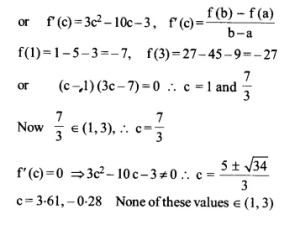
Ex 5.8 Class 12 Maths Question 6.
Examine the applicability of Mean Value theroem for all three functions given in the above Question 2.
Solution.
(i) F (x)= [x] for x ∈ [5,9], f (x) = [x] in the interval [5, 9] is neither continuous, nor differentiable.
(ii) f (x) = [x], for x ∈ [-2,2],
Again f (x) = [x] in the interval [-2,2] is neither continous, nor differentiable.
(iii) f(x) = x²-1 for x ∈ [1,2], It is a polynomial. Therefore it is continuous in the interval [1,2] and differentiable in the interval (1,2)
f (x) = 2x, f(1) = 1 – 1 = 0 ,
f(2) = 4 – 1 = 3, f'(c) = 2c

NCERT Class 12 Maths
Class 12 Maths Chapters | Maths Class 12 Chapter 5
Chapterwise NCERT Solutions for Class 12 Maths
-
NCERT Solutions For Class 12 Maths Chapter 1 Relations and Functions
NCERT Solutions For Class 12 Maths Chapter 2 Inverse Trigonometric Functions
NCERT Solutions For Class 12 Maths Chapter 3 Matrix
NCERT Solutions For Class 12 Maths Chapter 4 Determinants
NCERT Solutions For Class 12 Maths Chapter 5 Continuity and Differentiability
NCERT Solutions For Class 12 Maths Chapter 6 Application of Derivatives
NCERT Solutions For Class 12 Maths Chapter 7 Integrals
NCERT Solutions For Class 12 Maths Chapter 8 Application of Integrals
NCERT Solutions For Class 12 Maths Chapter 9 Differential Equations
NCERT Solutions For Class 12 Maths Chapter 10 Vector Algebra
NCERT Solutions For Class 12 Maths Chapter 11 Three-dimensional Geometry
NCERT Solutions For Class 12 Maths Chapter 12 Linear Programming
NCERT Solutions For Class 12 Maths Chapter 13 Probability
| NCERT Solutions for Class 12 All Subjects | NCERT Solutions for Class 10 All Subjects |
| NCERT Solutions for Class 11 All Subjects | NCERT Solutions for Class 9 All Subjects |

Post a Comment
इस पेज / वेबसाइट की त्रुटियों / गलतियों को यहाँ दर्ज कीजिये
(Errors/mistakes on this page/website enter here)